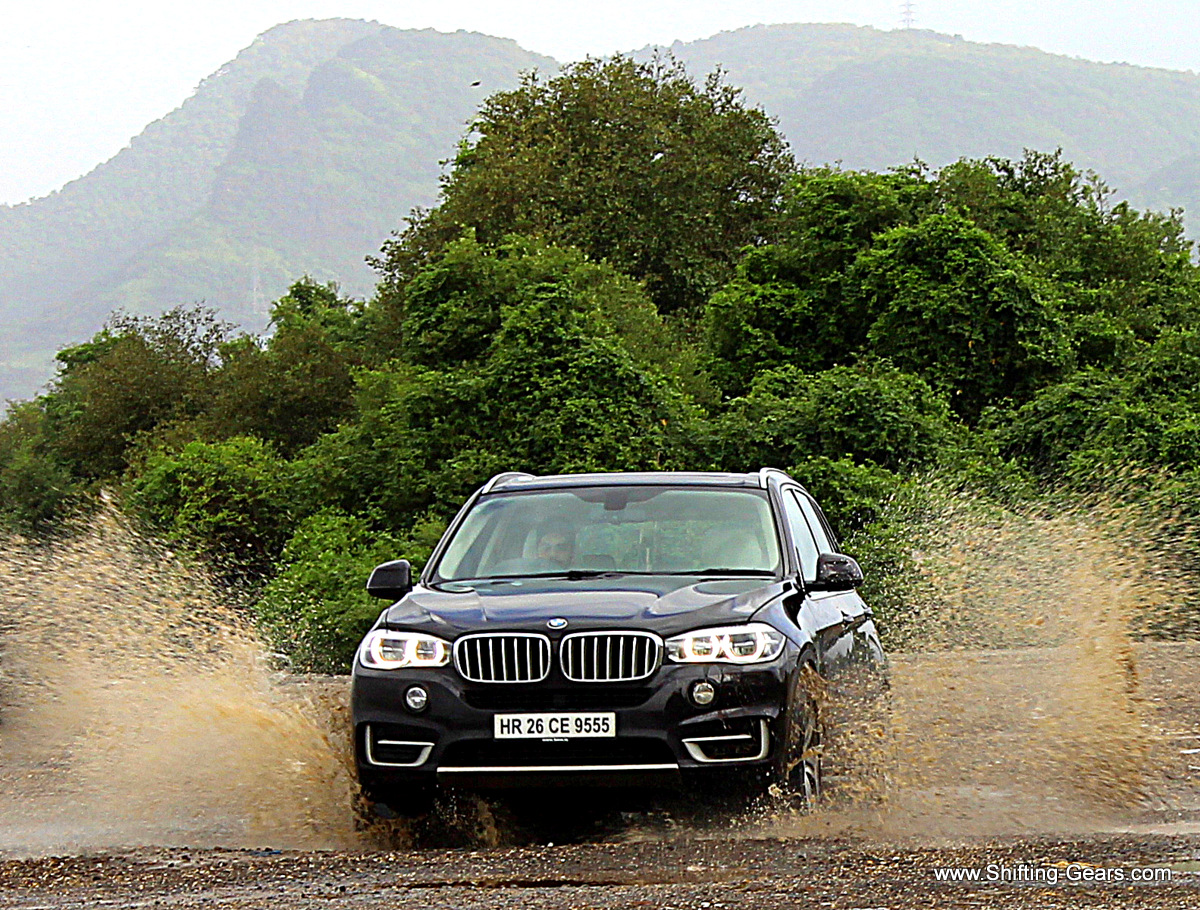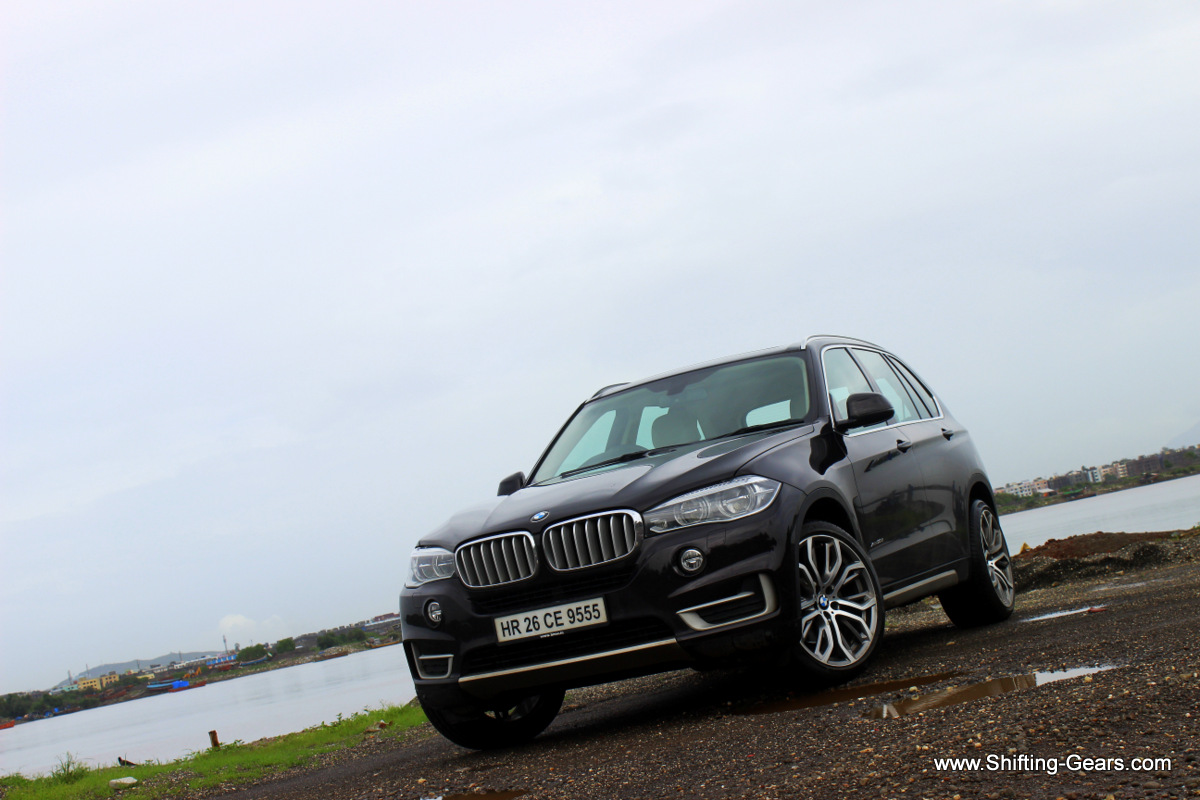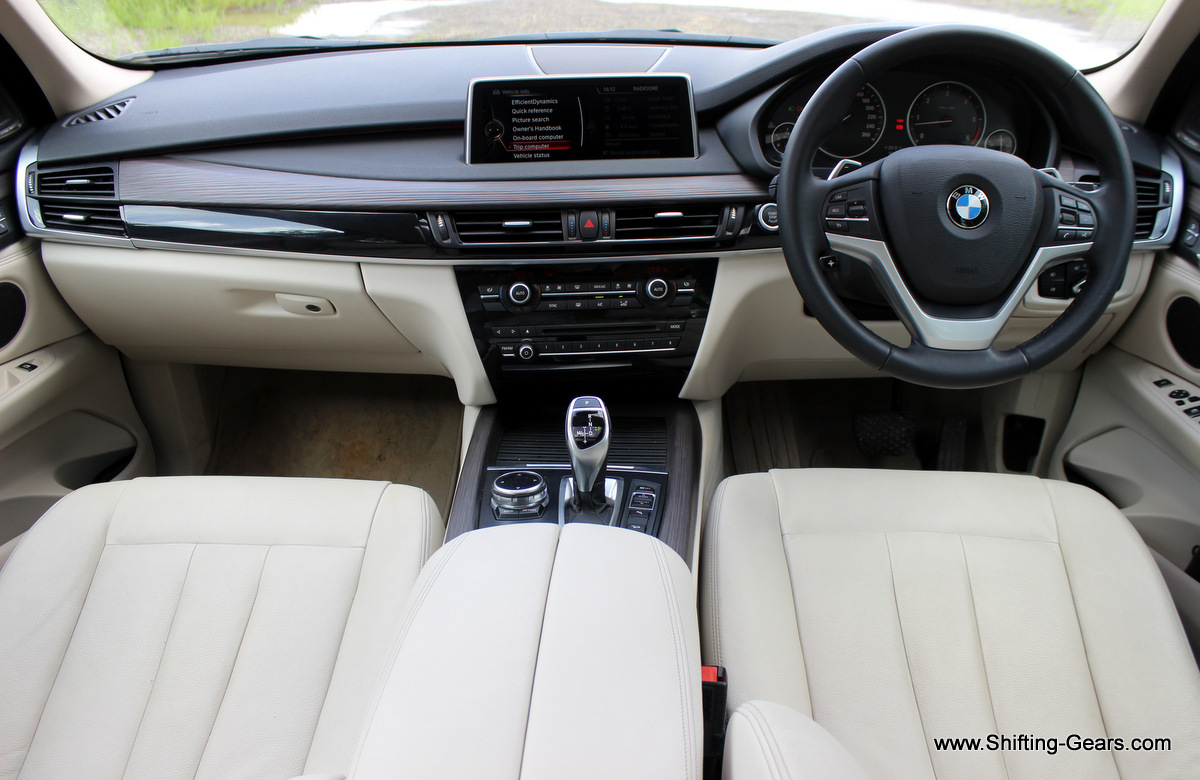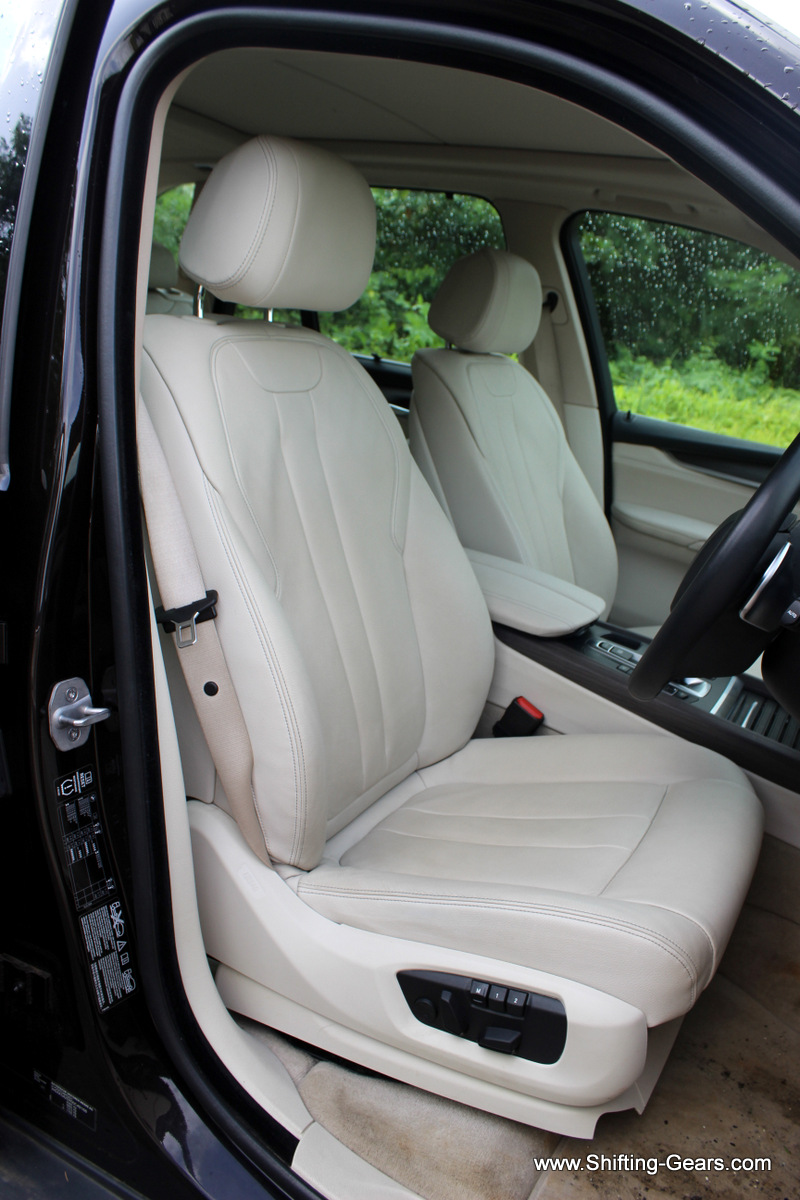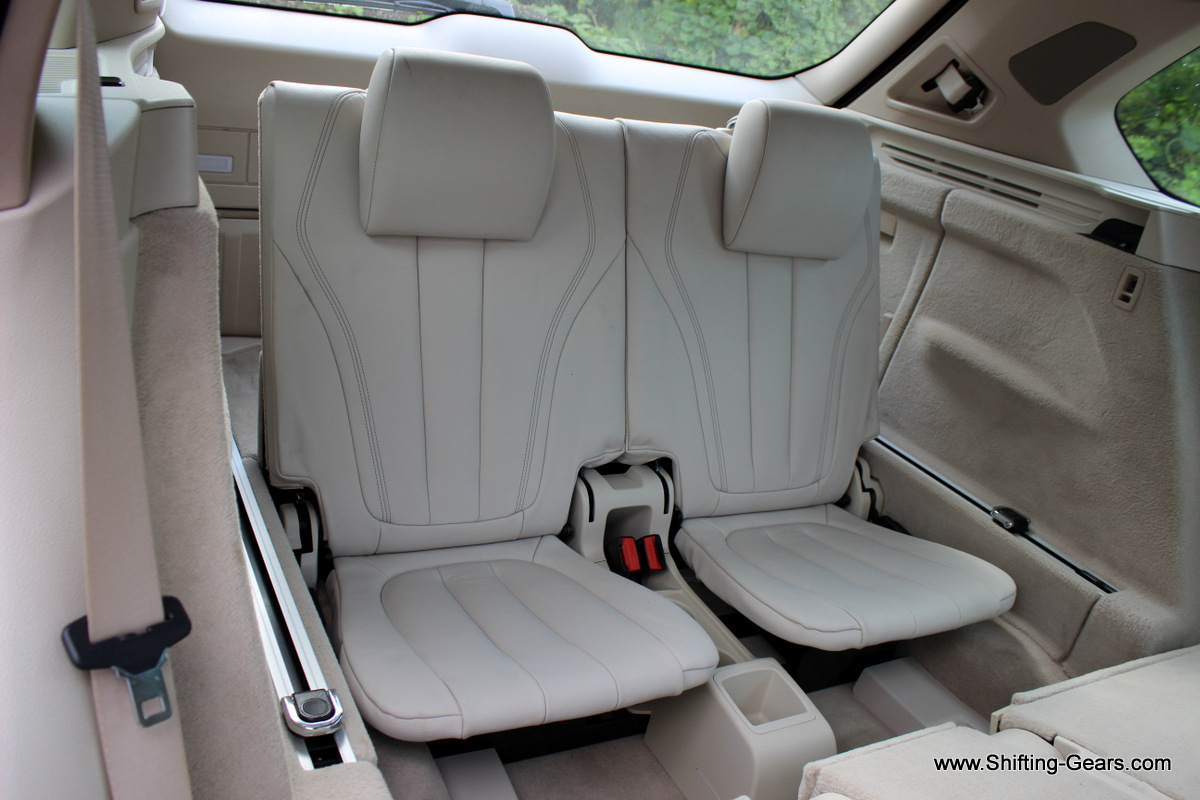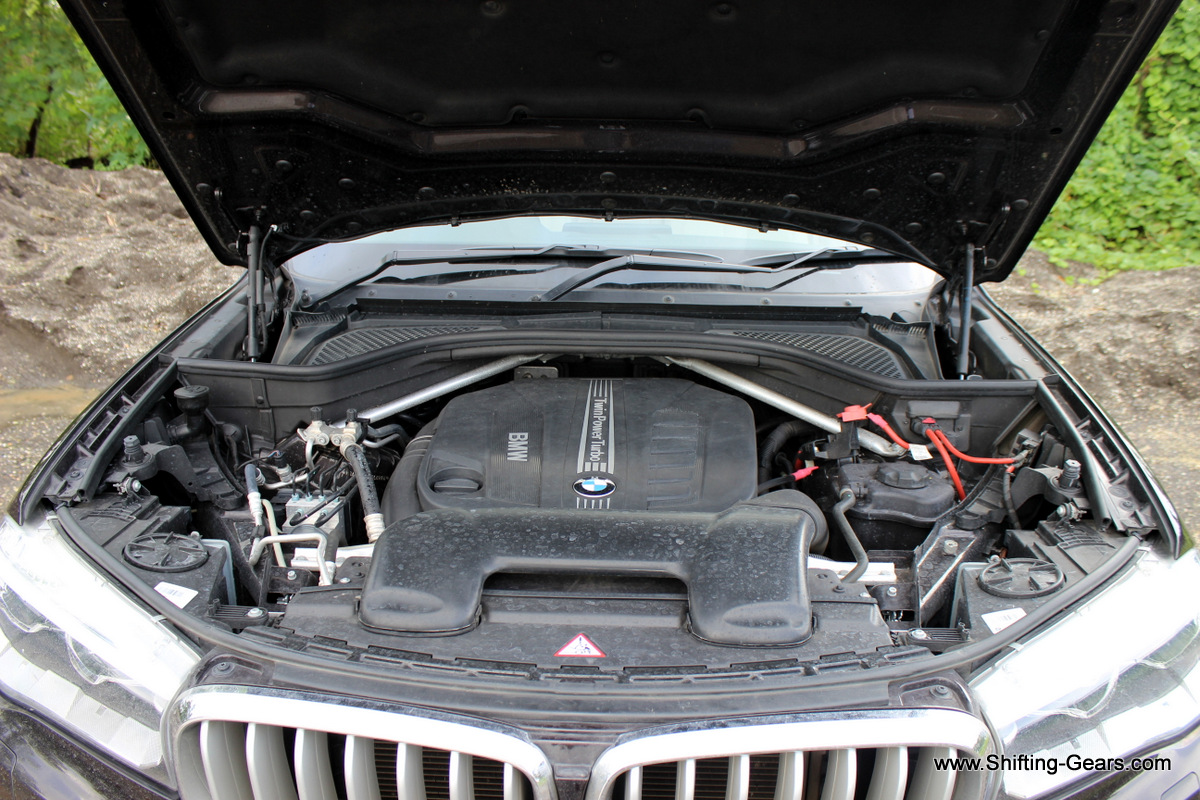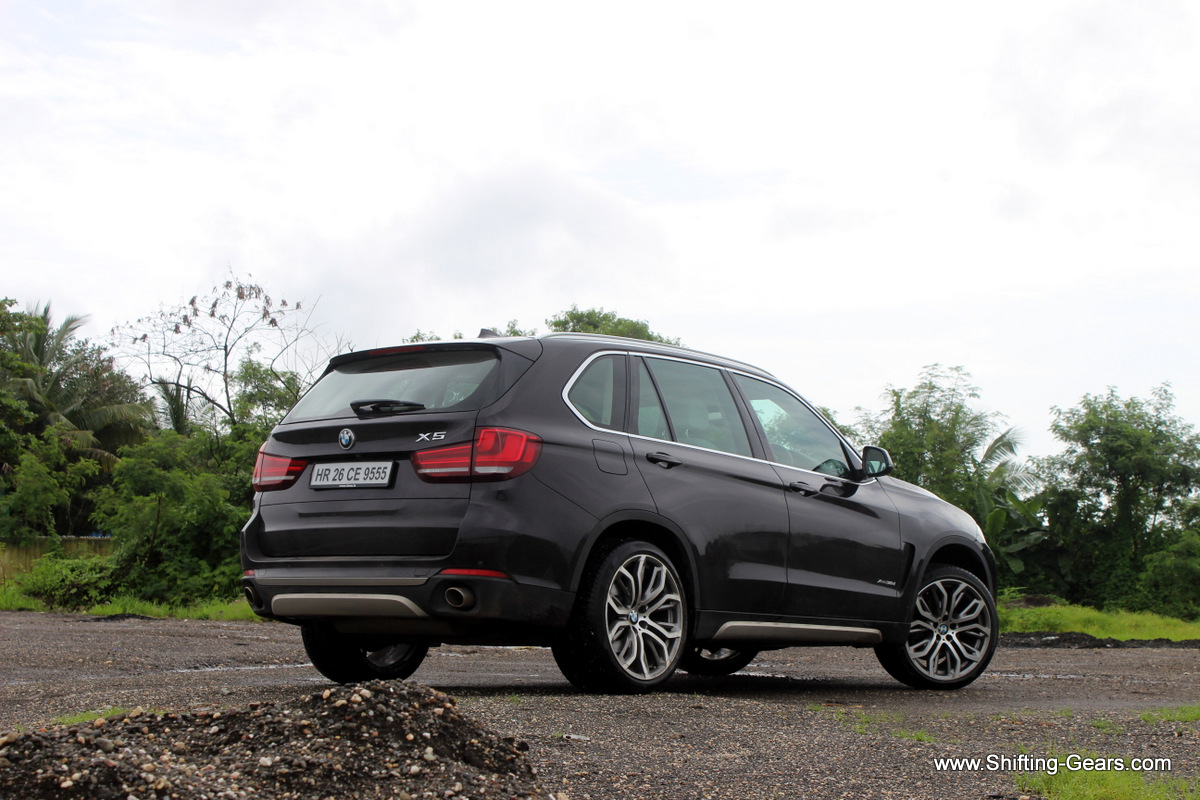The BMW X5 has been a midsize luxury SUV sold all across the globe for quite some time. The very first BMW X5 made its debut in 1999 and was codenamed as the E53. The E53 was also BMWs first SUV which featured the 4WD system. The first generation X5 was available for sale till 2006, when the second generation model came out. The second generation was codenamed as the E70 and was available till 2013. The new X5 sold now is in its third generation. BMW likes to call the X5 as a Sport Activity Vehicle (SAV) rather than a SUV. Codenamed as the F15, the latest generation BMW X5 made its debut appearance in 2013. The F15 is manufactured at BMW’s South Carolina plant in the US. The SUV is sold in India via the CKD route, to gain some price advantage.
Exteriors:
If you compare the F15 to the E70, the former looks much better now. The design is typical of BMWs but is a lot better compared to the previous generation. However, it is more of an evolution than revolution over here. At the front, the car now gets a wider kidney grille and headlamps which are slightly narrower than before. Also, the headlamps reach out to the kidney grille as we have seen starting from the F30 3 Series. Front bumper has been redesigned and gets titanium look mouldings. Fog lamps have also been moved slightly on the inner side and are LED units. The car gets adaptive bi-xenon LED headlamps with LED DRL rings and accent lights. BMW carries forward the design of placing a small air dam like section just below the kidney grille, as seen even on the E70. Crease lines and power bulge on the bonnet have been toned down on the F15. Front bumpers also get air breathers for better aerodynamics. Side profile of the car now misses out on the body mouldings on the door and gets a crease line instead. Turn indicator has been removed from the front fender and is placed on the ORVMs now. Also, behind the front wheel arch, you will notice another air breather for better aerodynamics. There is a thing plastic moulding running across the entire car as a skirting. Window sills get a satinated aluminium moulding and adds that little bit extra to the premium appeal. The chunky roof rails seen on the earlier generation have now been replaced with short units, only noticeable because they are finished in satinated aluminium. Our test car was equipped with not so India friendly 21″ alloy wheels, however, the stock X5 comes with 18″ double-spoke, 446 style alloy wheels shod with 255/55 R18 rubber. At the back, the new X5 misses out on the prominent and jutting out rear spoiler and has a small section over the rear windscreen just posing like one. Tail lamps are now all LED and have a different design as well. Rear bumper gets titanium look mouldings and also houses dual chrome finished exhaust tips on either side. Reversing camera is placed under the BMW logo, in the number plate recess. Boot lid is openable in two parts, the top half being electric and the lower section being manual. One cannot open the lower section without opening the top one, and also, to shut the top section, you have to securely close the lower one first. All doors get puddle lamps to provide assistance in the dark. A shark fin antenna, a signature BMW feature is present as well. On top, you get a XL size panoramic sunroof divided into two. To slide it open, only the front half moves backward. However, if you pop it up into the recirculation mode, both the glass sections move up. And in this position, it does look very visually pleasing. Fit and finish, paint quality etc. are consistent, as you would expect from a car costing over seventy big ones. However, at the front, the kidney grille section has increased in size along with leaving a small gap between the bonnet. This gap is noticeable when looked head on. If you look closely, this panel gap is wider than the gaps all around the car. The car is surrounded by parking sensors and helps you get in and out of those tight spots. However, these units are over sensitive and every time someone even walks close to the car, they start beeping. Can be annoying at times. You can manually turn it off, but every time you start the car, it switches on by default.
Overall, the X5 has massive road presence and has gained 29mm in length and 5mm in width over its previous generation.
Interiors:
Interiors of the car are a big step up compared to the outgoing model. There are a lot of revisions and additions to the car on the inside. Interior trim is available in textured fine-wood and one can choose from a total of six upholstery combinations. Our test car had the Canberra beige upholstery in Dakota leather. Dashboard has the top section in black while the lower half is in beige, and these two are separated by a wooden accent and a piano black strip running across. Horizontal crease lines on the dashboard make the car look wider from the inside. On either side, you get dual AC vents, to direct air flow more efficiently. In the centre, on top of the dashboard sits the iDrive display which is 26cm colour display and is DVD compatible as well. Steering wheel is familiar territory and provides decent grip being wrapped in leather. Paddle shifts are available for times when you feel a little enthusiastic. Also, steering is electrically adjustable. Centre console gets a piano black finish and is not too much of a dust / lint magnet. It stayed reasonably clean during our test drive. What makes the interiors more special are the ambient lights, which are the highlight when driving at night. You can chose between colours such as orange, white and blue in multiple combinations to suit your taste. These lights envelope the car from all sides including the dashboard and front and rear doors. Gear stalk is the same old unit seen on plenty of BMW cars. Next to the gear stalk you find the iDrive controller, driving mode selector, park assist buttons, hill descent button, traction control button and the parking brake button with auto hold function. Ahead of the gear stalk you get dual cup holders, a cubby hole and a cigarette lighter with a sliding cover. Head unit is a 600W Harman Kardon surround sound system with 16 speakers (including tweeters). Playback during radio is also crystal clear. The sound quality will please all and offend none. Automatic climate control has a total of 4 zones, two for the front passengers and two for the second row passengers. It managed to keep the cabin cool on a relatively hot day even during monsoons.
Front seats are supportive, but were slightly harder than we would call it the right compound. Seats provide good lateral and lumbar support and keep the driver in place. Electrically adjustable, the driver seat gets memory function while the passenger seat only has electric adjustment. With electric steering adjustment and electric seats, it is fairly easy to find the right driving position. Glove box is size small and gets felt lining. Do not expect it to eat up a large size purse of big files, it just won’t. Front driver armrest is fixed and does not have the fore and aft sliding function. It pops open in two to reveal the USB + Aux-in slots and a storage bin below.
Interiors Rear:
Second row door opens wide enough for easy ingress and egress. The cabin feels super airy with the beige interiors and is very bright in day time. Beige carpet however is going to be a pain to maintain and gets dirty instantly. Second row seats have fore and aft adjustment range. Seats can be moved front and back for 80mm and the seatback has a 10 degree recline angle. Seat back gets a 40:20:40 split and this aids the practicality while carrying extra luggage. Seats can even tumble down to accommodate more cargo. Dual zone climate control even for the rear passengers and another AC vent on the B pillar helps maintaining temperature at the back. Seats are again on the harder side and that coupled with our stiff ride quality running on 21″ wheels was a bit less than ideal. However, do note that ride quality & cabin comfort will be significantly better on stock 18″ rims. Opening the door at night not only has a puddle lamp on the door, but one assist light under the seat to help you while stepping inside.
The X5 Design Pure Experience, which is the top of the line variant is a 7 seater, while the cheaper Expedition version is a 5 seater. Although you have seating capacity for 7, the third row can be occupied only by kids. The seats are size small and the seat height from the floor is too low for a taller occupant to be here with a smile. Yes, short distance with 7 will be welcome, but anything going above an hour or so, the third row occupants are going to demand for a switch. You need to tumble the second row seats to get to the third row. No AC vents are to be seen here, but they get a speaker placed on the D pillar. Two cup holders and a small storage spot placed between the two third row seats. Seat base is visibly thin and the little we talk about comfort over here, the better. Boot space is generous when the third row is folded away and gets even better when you tumble down the second row seat as well. However, loading cargo inside is a trouble because the lower section of the two part boot which drops down, takes you away from the car a bit. It is not advisable to sit on top of this while pushing cargo inside. No spare wheel provided.
Engine:
BMW offers the new X5 with only one engine option, which is the diesel xDrive30d. The SUV, or SAV as BMW likes to call it is powered by a 2,993cc, 6-cylinder, TwinPower Turbo engine pumping out 258 BHP of power @ 4,000 RPM and 560 Nm of torque @ 1,500-3,000 RPM. Gearbox is an 8-speed steptronic sport automatic and the car gets a total of four driving modes such as Eco Pro, Comfort, Sport and Sport+. The xDrive name suggests that this is a 4WD and it has a variable torque split. Ground clearance is rated at 209mm and claimed 0-100 kmph stint is at 6.9 seconds.
Fire up the engine and it’s noticeable that there is a diesel heart under the hood. Feather the accelerator and the engine starts rolling with ease with the ample torque on tap. Punch the accelerator and the 258 horses come into action. For a weight of over 2 tonnes, the power on tap and the power delivery is exceptional and will surely keep enthusiasts happy. In sport mode, the car revvs till the redline without any fuss and does not feel strained either. Power and torque is spread out well throughout the revv range and makes playing with those paddle shifts a lot more fun. Overtaking manoeuvre needs just a firm tap on the accelerator and the car drops a ratio or two to move faster. With a strong mid-range, the engine is always eager to churn out a little more all the time. The 8-speed gearbox brilliantly handles city traffic without too much of throttle input. In Eco Pro mode, the auto start/stop function gets activated and turns the car off every time it comes to a halt. Although this might save fuel, it will kill the engine mounts a lot faster. What some might dislike, but we actually like, is that the engine sounds slightly gruff when you punch that accelerator pedal. The engine noise during this time is audible inside the cabin and we actually enjoyed being able to hear what’s happening under the hood. While feathering the accelerator though, with music on, there will be no diesel clatter heard in the cabin at all.

While cruising on the highway and feathering the accelerator pedal at around 80 kmph, the car returned a fuel efficiency figure of 16.6 kmpl. Not bad at all. Long highway trips will be easy on your wallet.
Want to know the fuel efficiency numbers? Most of the times the car managed to deliver an average of 8-10 kmpl, but while we were cruising on the highway, the X5 came up with a brilliant 16.6 kmpl figure. Now that is really something for a car weighing upwards of two tonnes with 258 BHP on tap.
BMW provides the Servotronic steering with the X5, which is electric. Putting the car in sport mode or sport+, the steering does get noticeably heavier. But heavier doesn’t really mean more responsive. Electric steering’s are known to be slightly vague in the feedback they offer and it is no different even on the X5. Centre back action is disappointing at times and then, the heavier steering actually pricks you a little rather than helping you enjoy. The good thing about sprinting in sport mode is that the softer suspension setup is changed to a relatively flat setting and the car gets rid of the float. How? BMW provides the adaptive suspension package for better comfort with self-levelling rear air suspension. Make no mistake though; the X5 is no corner carver. It is a heavy and tall car and body roll is noticeable. Also, coupled with the vague electric steering, cornering is not that fun either. Overall city commuting in comfort mode will provide good ride quality, also on slightly uneven patches. But if you switch to sport modes, the switch to a stiffer suspension setup will be evident.
Chassis has extensive use of ultra-high tensile steel in its monocoque body shell. This has also helped BMW to shed a few kilos compared to the outgoing model. Thermoplastics on the side panels, magnesium in the instrument cluster, aluminium in the hood etc. has made the X5 the lightest vehicle in its class.
Talking about safety features the BMW X5 xDrive30d Design Pure Experience comes equipped with dual front airbags, front and rear head airbags, side airbags for driver and front passengers, ABS with brake assist, cornering brake control (CBC), dynamic stability control (DSC), dynamic traction control (DTC), electric parking brake with auto hold, hill descent control, immobiliser with crash sensors, run flat tyres with reinforced side walls and run flat indicators, pyrotechnic seat belt tensioners and isofix child seat mounting.
One can opt for the BMW Secure Advance package which offers tyres, alloys, engine shield, interior protection cover and key lock out assistance.
If you want a good 5-seater premium SUV with 2 extra seats to occupy your kids, the X5 is a brilliant package. With the car being locally assembled, the X5 is also priced competitively. With lots of space adding to the practicality, along with the 258 horses under the hood, the X5 can serve well as a city commuter as well as a people carrier on those long weekends. It looks better than before and also, has more tech than before.

